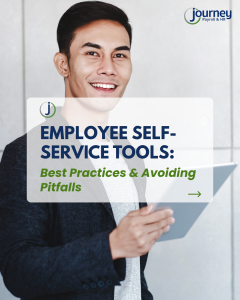Employee self-service (ESS) tools have become a cornerstone of modern workplaces. Whether it’s accessing pay stubs, reviewing benefits, or updating personal information, these tools empower employees to take control of their HR needs and they save HR teams countless administrative hours. But while the advantages are clear, self-service tools can also create challenges if they’re not implemented thoughtfully. Here’s how to make sure your ESS system enhances your workplace rather than complicates it.
 Why Self-Service Matters
Why Self-Service Matters
For employees, convenience is the biggest draw. They can access payroll details, benefits information, PTO balances, and tax forms anytime, anywhere. This level of access makes it easier for employees to manage their own information without waiting on HR for routine requests.
For HR teams, ESS tools streamline processes and reduce repetitive administrative work. By automating common tasks, HR professionals are freed up to focus on more strategic initiatives, such as culture, retention, and development.
And finally, ESS tools create transparency. When employees can view their data in real time from pay history to benefit elections it fosters trust and helps ensure accuracy across the board.
Best Practices for Implementing Self-Service Tools
Choose User-Friendly Platforms
The first step toward successful implementation is selecting an intuitive, user-friendly system. Complex dashboards discourage participation and can quickly lead to frustration. A well-designed interface with clear navigation and mobile accessibility ensures employees actually use the tool.
Offer Training & Support
Even the most intuitive system requires some guidance. Don’t assume employees will immediately know how to navigate new software. Offer short tutorials, quick-start guides, or FAQs to help them get comfortable. During the initial rollout, providing live support or walk-through sessions can make adoption much smoother.
Set Clear Boundaries
Clarity is key when defining what employees can and cannot do within the system. For example, they might be able to update their home address or emergency contact information but require approval before changing their tax withholding status. Setting these boundaries early prevents confusion and compliance issues down the road.
Keep Data Secure
Because self-service systems store sensitive employee data from payroll details to benefit elections data protection must be a top priority. Choose a platform that includes encryption, multi-factor authentication, and role-based access to ensure the right people see the right information.
Monitor & Update Regularly
Like any business tool, ESS platforms should evolve alongside your organization. Regularly review usage reports and collect employee feedback to identify areas for improvement. Stay on top of software updates and security enhancements to keep the system running smoothly and securely.
Common Pitfalls to Avoid
A few common mistakes can derail even the best self-service rollout. One is poor communication, introducing new tools without clear explanation often leads to confusion and low participation. Employees need to understand how and why the system benefits them.
Another pitfall is over-automation. While ESS tools streamline HR functions, removing all human interaction can leave employees feeling unsupported. It’s important to maintain accessible HR touchpoints for questions or concerns that require a personal touch.
Finally, ignoring compliance requirements can create serious issues. Some updates, such as changes to tax withholdings or benefit selections, must still pass through proper compliance checks rather than being left entirely to self-service.
Final Thoughts
When implemented correctly, employee self-service tools can transform the HR experience for both employees and administrators. They’re not meant to replace your HR team but to empower them and your employees through convenience, transparency, and efficiency. With the right balance of training, security, and ongoing support, self-service tools can save time, boost engagement, and help your company stay compliant while creating a more empowered workforce.